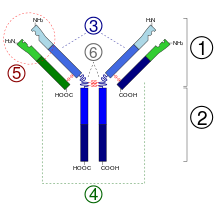User:Nnkarma12/sandbox

Immunoglobulin class switching recombination (CSR), or isotype switching, occurs in B cells and refers to the change in the heavy chain of antibodies caused by cytokines during an adaptive immune response. Immunoglobulins have four interlinked polypeptide chains, two heavy chains and two light chains.[1] The heavy chain determines the antibody class and therefore its effector function. The lower half of the heavy chain is called the Fc region, or variable end. The upper half of the heavy chain and the light chain are the antigen presenting site. This is where the antigen and the immunoglobulin bind in a lock-and-key type interaction, starting an immune response. This immune activation, causes a release of cytokines inducing the production of B cells in the bone marrow. Naive B cells that have never been in contact with a pathogen will produce a particular membrane bound antibody: IgM, or immunoglobulin M. In placental mammals there are five immunoglobulin isotypes known as IgA, IgD, IgE, IgG, and IgM. They are each named with an "Ig" prefix that stands for immunoglobulin, a name sometimes used interchangeably with antibody. As the B cell matures, it will express both IgG and IgM. This co-expression renders the B cell capable of responding to an antigen. The antigen will need to bind to the surface bound antibody in order for the B cell to start releasing antibodies in the blood plasma or the lymphatic system. This, now antibody producing cell, is called a plasma cell. [2]
Mechanism[edit]
Class switching recombination occurs through the detachment of a heavy chain VDJ (variable) region from a C (constant) region and joins it to a downstream C region. The DNA in between the two C regions is deleted. The constant region of an antibody determines how the antibody will react with the antigen.The recombination of the C region will change the effector function of the antibody without changing its affinity to the antigen (which is determined by the light chain).[3] Recombination junctions occurs between switch (S) regions on the H chain locus. Switch regions are repetitive G-rich sequences 2-10kb in length [4] within introns so the recombination does not affect the functional sequence length or structure of the heavy chain.[5]

The order of the heavy chain exons are as follows:
Class switching recombination is initiated in B cells by activation-induced cytodine deaminase (AID) which converts cytosines (dC) in the S regions to uracils (dU) by deamination. The deamination process activates the base excision repair (BER) pathway creating single-stranded DNA breaks (SSBs) through ubiquitous DNA repair. The glycosylase UNG has been found to be the main uracil DNA glycosylate to excise the dU residue creating the abasic sites. These sites are then repaired by apurinic/apyrimidinic endonucleases (APE).[7]
Cytokines responsible for class switching[edit]
Naive B cells can switch to any isotype, and the cytokines released by the T cells, can influence what immunoglobulin classes will be expressed on the B cell. The mechanism of this switch is described above. Below lay two tables showing mouse and human immunoglobulin class switching in respect to cytokines.
| T cells | Cytokines | Immunoglobulin classes | |||||
|---|---|---|---|---|---|---|---|
| IgG1 | IgG2a | IgG2b | IgG3 | IgG4 | IgA | IgE | |
| Th2 | IL-4 | ↑ | ↓ | ↓ | ↓ | ↓ | ↑ |
| IL-5 | ↑ | ||||||
| Th1 | IFNγ | ↓ | ↑ | ↓ | ↑ | ↓ | ↓ |
| Treg | TGFβ | ↑ | ↓ | ↑ | |||
| IL-10[8] | ↑ | ||||||
| T cells | Cytokines | Immunoglobulin classes | |||||
|---|---|---|---|---|---|---|---|
| IgG1 | IgG2 | IgG3 | IgG4 | IgA | IgE | ||
| Th2 | IL-4 | ↑ | ↓ | ↑ | ↑ | ||
| IL-5 | ↑ | ||||||
| Th1 | IFNγ | ↓ | ↑ | ↓ | |||
| Treg | TGFβ | ↓ | ↑ | ||||
| IL-10[9][10] | ↑ | ↑ | |||||
References[edit]
- ^ "Immunoglobulins". myplace.frontier.com. Retrieved 2016-04-27.
- ^ Widmaier, Eric P. (2011). Vander's Human Physiology: The Mechanism of Body Function, Twelfth Edition. McGraw-Hill. ISBN 978-0-07-337810-7.
- ^ Stavnezer J, Amemiya CT (2004). "Evolution of isotype switching". Semin. Immunol. 16 (4): 257–75. doi:10.1016/j.smim.2004.08.005. PMID 15522624.
- ^ Maizels, Nancy. "Immunoglobulin Gene Diversification". Annual Reviews. Annual Reviews.
- ^ Stavnezer, Janet; Jeroen E.J. Guikema; Schrader, Carol E. (2008-01-01). "Mechanism and Regulation of Class Switch Recombination". Annual Review of Immunology. 26 (1): 261–292. doi:10.1146/annurev.immunol.26.021607.090248. PMC 2707252. PMID 18370922.
- ^ Parham, Peter (2015). The Immune System (4th ed.). Garland Science.
- ^ Janeway, Charles (2001). Immunobiology. (5th ed.). Garland Science. ISBN 0-8153-3642-X.
- ^ Shparago, N.; Zelazowski, P.; Jin, L.; McIntyre, T. M.; Stuber, E.; Peçanha, L. M.; Kehry, M. R.; Mond, J. J.; Max, E. E. (1996-05-01). "IL-10 selectively regulates murine Ig isotype switching". International Immunology. 8 (5): 781–790. ISSN 0953-8178. PMID 8671667.
- ^ "Human interleukin 10 induces naive surface immunoglobulin D+ (sIgD+) B cells to secrete IgG1 and IgG3". The Journal of Experimental Medicine. 179 (2): 757–762. 1994-02-01. ISSN 0022-1007. PMC 2191366. PMID 8294883.
- ^ "Interleukin-10 induces immunoglobulin G isotype switch recombination in human CD40-activated naive B lymphocytes". The Journal of Experimental Medicine. 183 (3): 937–947. 1996-03-01. ISSN 0022-1007. PMC 2192363. PMID 8642297.

